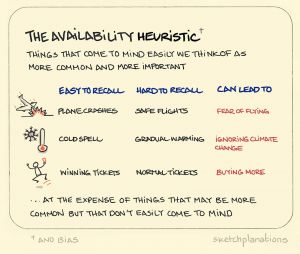Heuristics: Difference between revisions
mNo edit summary |
mNo edit summary |
||
| Line 1: | Line 1: | ||
[[File:Heuristic.png|alt=Heuristic|thumb|'''''Figure 1'''. Heuristics are mental shortcuts.'']] | |||
'''A cognitive heuristic are mental shortcuts we use to make decisions or solve problems quickly. While these shortcuts can help us think faster, their downside is that they can make us jump to conclusions without considering all the facts.''' Heuristics simplify information processing by employing rules of thumb or general guidelines, which can lead to systematic deviations from rational judgment. | |||
'''A cognitive heuristic | |||
A simple example is imagine you're trying to figure out if it'll rain tomorrow. Instead of checking the weather forecast, you just look out the window today and think, "''Well, it's sunny today, so it'll probably be sunny tomorrow too''." This mental shortcut is a cognitive heuristic. You're basing tomorrow's weather on what you see today, even though that's not always accurate. | A simple example is imagine you're trying to figure out if it'll rain tomorrow. Instead of checking the weather forecast, you just look out the window today and think, "''Well, it's sunny today, so it'll probably be sunny tomorrow too''." This mental shortcut is a cognitive heuristic. You're basing tomorrow's weather on what you see today, even though that's not always accurate. | ||
Latest revision as of 23:47, 25 August 2024
A cognitive heuristic are mental shortcuts we use to make decisions or solve problems quickly. While these shortcuts can help us think faster, their downside is that they can make us jump to conclusions without considering all the facts. Heuristics simplify information processing by employing rules of thumb or general guidelines, which can lead to systematic deviations from rational judgment.
A simple example is imagine you're trying to figure out if it'll rain tomorrow. Instead of checking the weather forecast, you just look out the window today and think, "Well, it's sunny today, so it'll probably be sunny tomorrow too." This mental shortcut is a cognitive heuristic. You're basing tomorrow's weather on what you see today, even though that's not always accurate.
Due to the energy frugal brain, a lot of our every day thinking is littered with these heuristics, here are a few of the most important to look out for:
Anchoring
A famous and very common heuristic is called the ‘Anchoring effect’. This suggests that the first piece of information we get is weighed much more heavily in our decision making process than subsequent pieces of information – regardless of their actual relative importance. You might know this as ‘first impressions’.
A simple example is imagine you're shopping for a shirt, and you see one originally priced at $100, but it's on sale for $50. You might think it's a great deal because you're comparing the sale price to the original price. This is the anchoring effect. You're "anchored" to that first number you saw ($100) and use it as a reference point to judge the value of the sale price. Even if the shirt is not worth $50, you might still buy it because it seems like a big discount from the original price. This is a very common dark pattern used in marketing.
Availability
The availability heuristic (closely related to the frequency illusion) involves making decisions based upon how easy it is to bring something to mind. When you are trying to make a decision, you might quickly remember a number of relevant examples. Since these are more readily available in your memory, you will likely judge these outcomes as being more common or frequently occurring.
For example, if you are thinking of flying and suddenly think of a number of recent airline accidents, you might feel like air travel is too dangerous and decide to travel by car instead. Because those examples of air disasters came to mind so easily, the availability heuristic leads you to think that plane crashes are more common than they really are.
Representativeness
The representativeness heuristic involves making a decision by comparing the present situation to the most representative mental prototype. When you are trying to decide if someone is trustworthy, you might compare aspects of the individual to other mental examples you hold. A sweet older woman might remind you of your grandmother, so you might immediately assume that she is kind, gentle, and trustworthy.
Affect
The affect heuristic involves making choices that are influenced by the emotions that an individual is experiencing at that moment. For example, research has shown that people are more likely to see decisions as having benefits and lower risks when they are in a positive mood. Negative emotions, on the other hand, lead people to focus on the potential downsides of a decision rather than the possible benefits.

